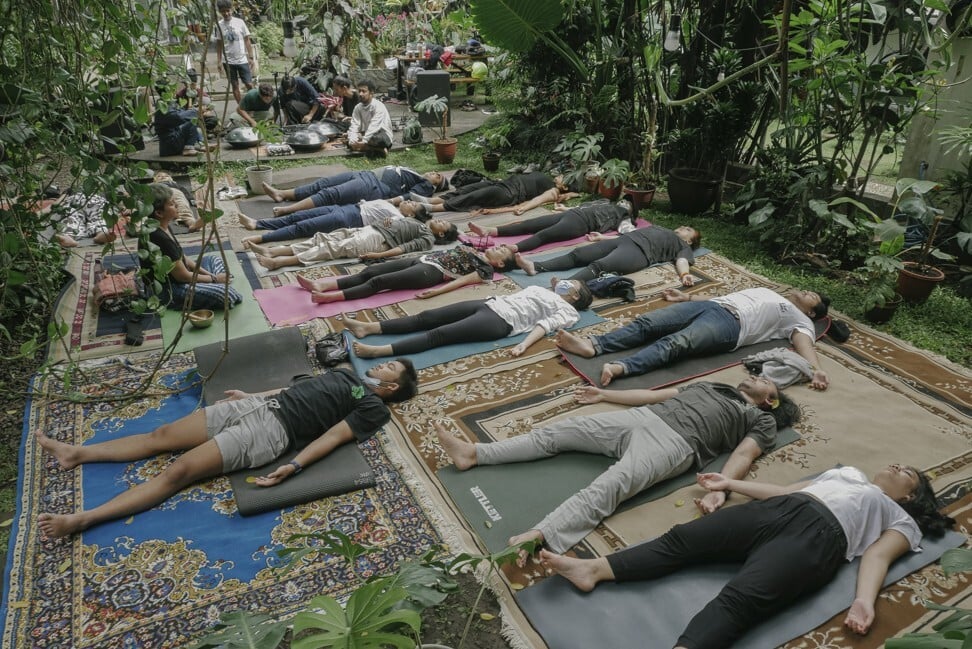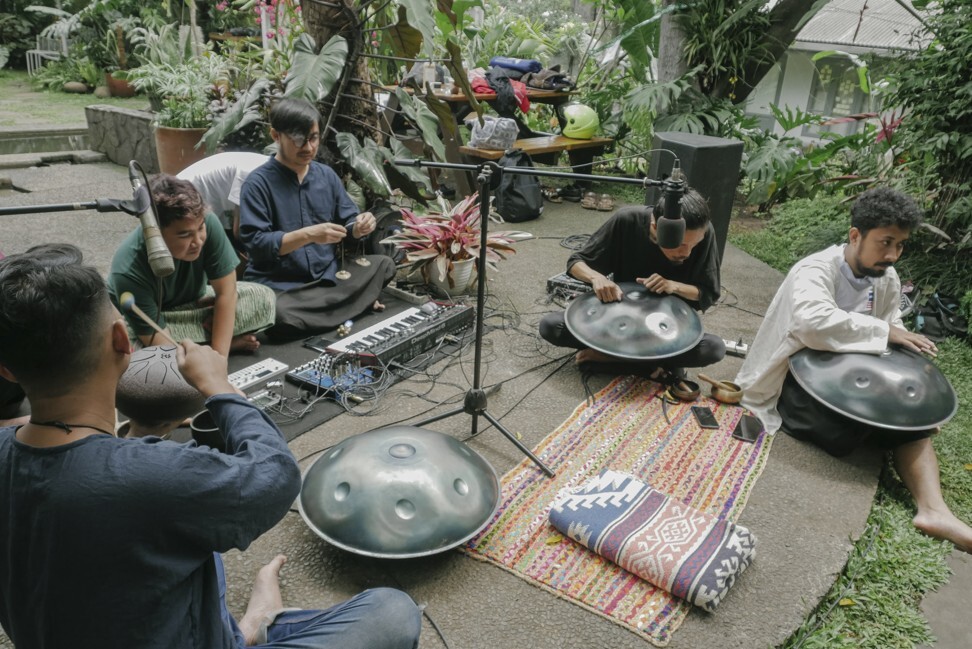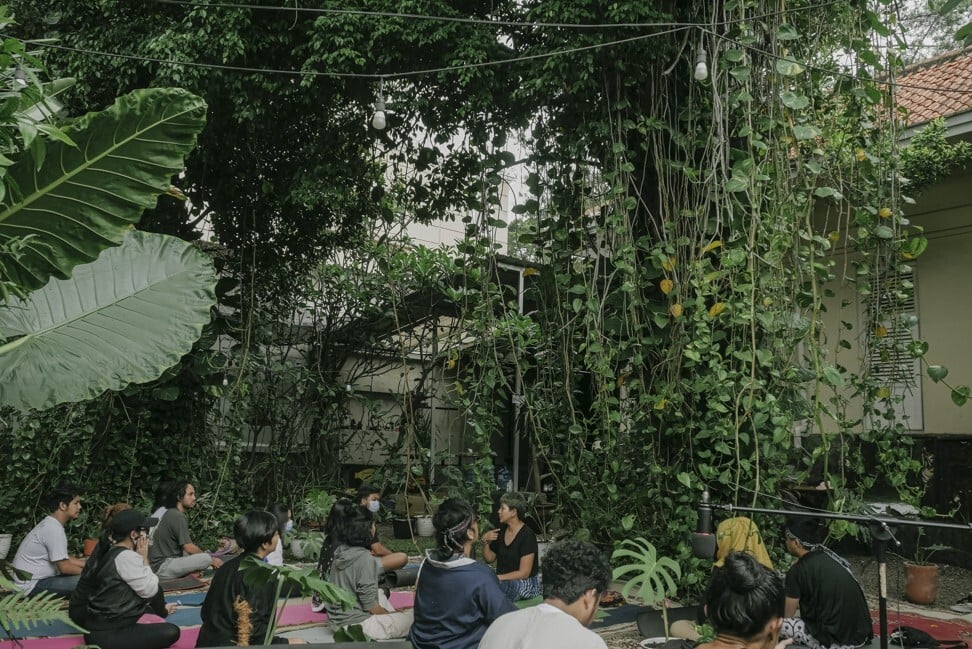
Music for plants: the Indonesian band using sounds and frequencies to relax them, and inviting audience members to bring their own
- Indonesian electronic music duo Bottlesmoker held their first plant-centric concert in July, playing to an audience who brought more than 150 house plants
- They even capture ‘sounds’ from the plants which they turn into different melodies and patterns

Indonesian musical duo Bottlesmoker have always been peculiar. Performing instrumental electronic music that brims with gleeful melody and danceable beats, they use vintage toys and game consoles, transistor radios and home-made sound machines alongside modern synthesisers to make their music.
These days, they’ve added something new to the mix: plants. Inspired by the experimental works of late Canadian electronic-music pioneer Mort Garson, particularly his 1976 album Mother Earth’s Plantasia, they have been playing conceptual concerts centred on plants – a novel idea that has won the duo a lot of attention.
“When we did our research for the shows, we found out there were many different types of music that work when playing with and for plants,” says band member Anggung “Angkuy” Suherman, 35. “We settled on the kind that would be best accepted by the plants.”
He founded Bottlesmoker – whose name is inspired by a bottle the duo made into an ashtray – in 2006 with Ryan “Nobie” Adzani, also 35, when they were both students at the communication faculty at Padjadjaran University in Bandung, West Java.

Their first plant-centric concert was held in July in Bandung and featured music with a mix of new age ambience and whimsical electronica. The duo directly referenced Mort Garson’s influence by dubbing the concert Plantasia.
Bottlesmoker played to an audience of more than 150 house plants, which were brought to the venue by their owners, most of whom were fans. The band mixed everything they had learned about playing music for plants with “local wisdom”, Angkuy says.
“We infused elements of Tarawangsa, which is a [musical] ritual form for rice seed from Rancakalong in Sumedang,” he adds, referring to a regency in West Java province. “We also utilised karinding, a traditional bamboo instrument used to repel pests from rice seeds – its frequency bothers pests.”
The 90-minute performance began at 4.30pm, which the duo’s research showed was an optimal time to provide “sound treatment” for the plants.
“Our repertoire is meant to summarise the cycle of a day into that 90 minutes, which through the music represents the morning, noon, late afternoon, evening and back again to the morning,” Angkuy explains.
While the idea sounds gimmicky, the show was visually striking and felt artistically credible.
Angkuy and Nobie’s research helped them to work out a few ground rules. They avoided low frequencies and used plenty of natural sound samples, including recordings of chirping birds and waterfall noises. Their music focused on repetitive major chords, all played at a frequency of around 5000hz, which they had learned was the optimal frequency to relax the plants.
The duo and their crew were even careful to avoid using any curse words before, during and after the event.
“We found out that plants are actually able to receive our negative and angry emotions, which can restrict their growth,” Nobie says.
The plants would create interesting sequences of notes that were often impossible to be performed by humans
The musicians included elements of classical string music, which they learned would help in “opening the stomata”, pores in the plant that control the rate of gas exchange. Angkuy says the stomata “react” to classical-style music and when opened, release carbon dioxide, water vapour and oxygen. This supposedly means the plants are “happy”, he says.
“When many plants are brought together in a room there is an interesting energy that pulls us in and calms us,” he adds. “Visually, it is also very soothing with all the green colours and the shape of the plants.”
The musicians communicated with the plants as they did with a human audience – bantering with them and literally touching them.
Bottlesmoker is one of Indonesia’s most surprising international breakthrough bands. Releasing albums at home and abroad and playing many international shows, the duo’s magnetism lies in their energetic live act, which often features conceptual visuals behind them. Their novel set-up may be the initial attraction, but it is their almost rave-party energy that gets people hooked, turning curious observers into fans.

From the Plantasia show, the duo discovered they were able to do more than just play for the plants. They could also use the plants as a sound source, attaching microphones and using the resulting “sounds” in their music.
Angkuy and Nobie learned from musicians who have done similar experiments that they could turn the organic elements of plants – such as water and air – into data (called a MIDI) that can be processed by computerised musical equipment. They programmed their own software to capture the data with as little human interference as possible, and found each plant presented a different type of data and, therefore, different melodies and patterns.
“The plants would create interesting sequences of notes that were often impossible to be performed by humans,” Nobie says.
Bottlesmoker has run many online workshops and concerts using this approach, including virtual broadcasts for cultural centres such as the Goethe Institut, a German language school, in Bandung, and Dutch cultural centre Erasmus Huis in Jakarta.
A subsequent concert, Monstera Soundbath, took place in a room filled with dozens of Monstera deliciosa – also known as Swiss cheese plants. A limited audience listened in resting and meditative yoga positions, sometimes lying down, while Bottlesmoker and guest musicians performed ambient music using, among other equipment, a Tibetan-Buddhist singing bowl called the tingsha. They are now planning more similar events.
“Turns out that it isn’t just Zen or ambient and other calming types of music that can relax the human mind, but also the Monstera plant when many of them are close to each other in the same room,” Angkuy says. “They can reduce the stress in a busy mind and cleanse the air. We thought, ‘well, why not combine that with sound?’”
The natural surroundings inspire a lot of energy to create a sound that motivates us, and to create music that translates what nature is saying to us, which is ‘please take care of us’
Randy Apriza, a long-time Bottlesmoker fan who took part in the Monstera Soundbath gig, says the experience was unlike any concert he has been to.
“It felt like I was floating on air for a bit, with the air getting chillier, and the singing bowl starts to reverberate that humming sound,” he says.
Marine Ramdhani, who runs the independent label Fast Forward Records and the Lou Belle venue, where both Plantasia and Monstera Soundbath were held, says he was excited to see plants being used beyond their usual decorative role.
The Bottlesmoker duo says that the pandemic has created “the most neutral time for creativity to exist”.
“As a musician, it is no longer about how many fans or followers, or how many shows you have, but how strong your creativity is to survive these times,” Nobie says.

Bottlesmoker’s plant music has been so successful that Nobie admits the group is putting music that doesn’t fit the concept on hold. “The success of this concept is confusing in a way, but also makes us happy,” he says.
It has been so successful that Bottlesmoker is now working with the Indonesian tourism ministry, and West Java’s department of tourism and culture, to set up performances shot in places of natural beauty. These include the Stone Garden park near Bandung and the Wayang-Windu twin volcanoes, both in West Java, and the Capella nature resort in Ubud, Bali.
The duo will perform an improvised set while “reacting” to their surroundings. The performance will be recorded and used to promote Indonesian tourism.

The musicians are having a blast riding the momentum, and they plan to expand beyond shows – which they still hope to do outdoors. They want to create more sound baths as well as nature-inspired art installations, including an upcoming event called “Singing Plants”.
According to Angkuy, what started off as mere curiosity, wanting another way to create music, has morphed into something deeper.
“The natural surroundings inspire a lot of energy to create a sound that motivates us, and to create music that translates what nature is saying to us, which is ‘please take care of us’.”